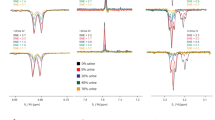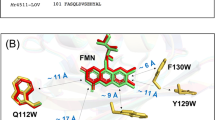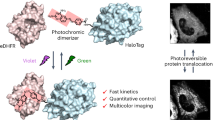Abstract
APPLICATIONS of chemically induced dynamic nuclear polarisation (CIDNP) have been limited so far to reactions of small organic molecules1,2. We report here the observation of CIDNP in the 360-MHz NMR spectrum of a protein. The effect is generated by a cyclic reaction of a photo-excited dye with certain amino acid residues that are accessible to the dye. Of the common amino acids polarisation has been observed in tyrosine, histidine and tryptophan. The method distinguishes between exposed and buried groups and thus yields valuable information on the solution structure of proteins. Here we discuss the CIDNP observed in tyrosine residues of bovine pancreatic trypsin inhibitor (BPTI). The three-dimensional structure of BPTI (molecular weight 6,500) has been studied extensively by X-ray crystallography3,4 and by NMR5,6.
This is a preview of subscription content, access via your institution
Access options
Subscribe to this journal
Receive 51 print issues and online access
$199.00 per year
only $3.90 per issue
Buy this article
- Purchase on SpringerLink
- Instant access to full article PDF
Prices may be subject to local taxes which are calculated during checkout
Similar content being viewed by others
References
Muus, L. T. et al. (eds) Chemically Induced Magnetic Polarization (Reidel, Dordrecht, 1977).
Kaptein, R. in Advances in Free-Radical Chemistry Vol. 5 (ed. Williams, G. H.) 319–380 (Elek Science, London, 1975).
Huber, R., Kukla, D., Rühlmann, A. & Steigemann, W. Cold Spring Harb. Symp. quant. Biol. 36, 141–150 (1971).
Deisenhofer, J. & Steigemann, W. Acta crystallogr. B 31, 238–250 (1975).
Snyder, G. H., Rowan, R. III, Karplus, S. & Sykes, B. D. Biochemistry 14, 3765–3777 (1976).
Wagner, G., De Marco, A. & Wüthrich, K. Biophys. Struct. Mech. 2, 139–158 (1976).
Kaptein, R., Dijkstra, K., Müller, F., van Schagen, C. G. & Visser, A. J. W. G. J. Magnetic Resonance (in the press).
McCormick, D. B. Photochem. Photobiol. 26, 169–182 (1977).
Kaptein, R. Chem. Commun. 732–733 (1971).
Closs, G. L. & Czeropski, M. S. Chem. Phys. Lett. 45, 115–116 (1977).
Kalk, A. & Berendsen, H. J. C. J. Magnetic Resonance 24, 343–366 (1976).
Brown, L. R., De Marco, A., Wagner, G. & Wüthrich, K. Eur. J. Biochem. 62, 103–107 (1976).
Kronman, M. J. & Robbins, F. M. in Fine Structure of Proteins and Nucleic Acids (eds Fasman, G. D. & Timasheff, S. N.) 271–416 (Marcel Dekker, New York, 1970).
Meloun, B., Fric, I. & Sorm, F. Eur. J. Biochem. 4, 112–117 (1968).
Sherman, M. P. & Kassell, B. Biochemistry 7, 3634–3641 (1968).
Author information
Authors and Affiliations
Rights and permissions
About this article
Cite this article
KAPTEIN, R., DIJKSTRA, K. & NICOLAY, K. Laser photo-CIDNP as a surface probe for proteins in solution. Nature 274, 293–294 (1978). https://doi.org/10.1038/274293a0
Received:
Accepted:
Published:
Issue date:
DOI: https://doi.org/10.1038/274293a0
This article is cited by
-
Detection of sub-nmol amounts of the antiviral drug favipiravir in 19F MRI using photo-chemically induced dynamic nuclear polarization
Scientific Reports (2024)
-
Multinuclear 1D and 2D NMR with 19F-Photo-CIDNP hyperpolarization in a microfluidic chip with untuned microcoil
Nature Communications (2023)
-
Sample illumination device facilitates in situ light-coupled NMR spectroscopy without fibre optics
Communications Chemistry (2022)
-
LED-Based Photo-CIDNP Hyperpolarization Enables 19F MR Imaging and 19F NMR Spectroscopy of 3-Fluoro-DL-tyrosine at 0.6 T
Applied Magnetic Resonance (2022)
-
The anatomy of unfolding of Yfh1 is revealed by site-specific fold stability analysis measured by 2D NMR spectroscopy
Communications Chemistry (2021)



